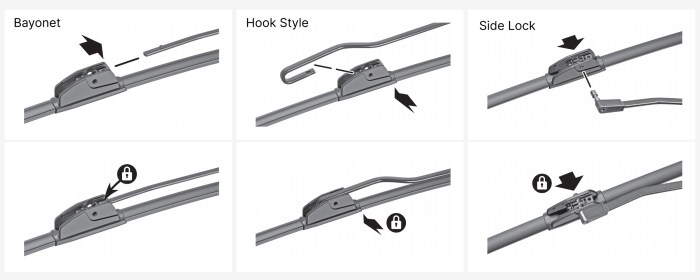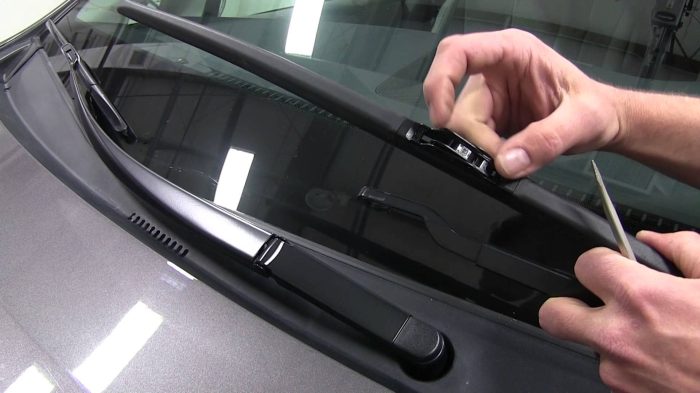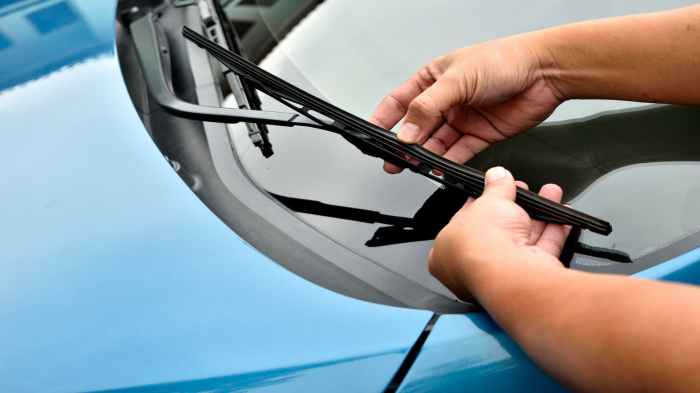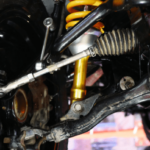How to change windshield wiper blades? It sounds kinda boring, right? But trust me, knowing this simple car maintenance task can save you some serious dough and maybe even prevent a fender bender on a rainy day. This guide will walk you through everything from identifying your car’s wiper blade type to installing the new ones and troubleshooting any hiccups along the way.
Get ready to become a wiper blade whisperer!
We’ll cover different wiper blade types (conventional, beam, hybrid – yeah, there are options!), how to choose the right ones for your ride, and the step-by-step process of swapping them out. We’ll even throw in some pro tips for keeping those wipers working like champs. So grab your tools (or just your phone, because this is super easy) and let’s get started!
Identifying Your Vehicle’s Wiper Blades
So, you’re ready to replace your wiper blades, but first things first: you need to know what kind you have! Finding the right wiper blades isn’t rocket science, but a little prep work goes a long way in ensuring a smooth, streak-free windshield. This section will walk you through identifying your vehicle’s wiper blade type so you can get the right replacements.Knowing your wiper blade type involves figuring out both the size and the style.
The size is usually measured in inches and is specific to your car’s make, model, and year. The style refers to the overall design of the blade, with the most common being conventional, beam, and hybrid.
Wiper Blade Size Determination
The easiest way to find the correct size is to check your owner’s manual. It usually has a diagram showing the wiper blade sizes for your specific model. Alternatively, you can usually find this information online by searching “[Your Car’s Make] [Your Car’s Model] [Your Car’s Year] wiper blade size.” Many auto parts websites have databases that allow you to search by vehicle information, making this process even faster.
For example, searching “2018 Honda Civic wiper blade size” will yield several results, usually specifying sizes for both the driver and passenger side blades (which might be different). If you can’t find the information online, you can always measure your existing blades. However, keep in mind that the measurement might be slightly off, and this is not as accurate as using the official specifications.
Wiper Blade Style Identification
There are three main wiper blade styles: conventional, beam, and hybrid.
- Conventional Wiper Blades: These are the classic wiper blades, featuring a rubber blade that is attached to a metal frame. They are the most common type, but can be less effective in cleaning than other styles.
- Beam Wiper Blades: These are a more modern design, with a single, flexible piece of rubber spanning the length of the blade. They offer a more consistent pressure across the windshield and tend to last longer.
- Hybrid Wiper Blades: These blades combine features of both conventional and beam blades. They often have a metal frame but a more streamlined design than a traditional conventional blade.
To determine your style, simply look at your current wiper blades. Consider the overall shape and construction. If it’s a single piece of rubber, it’s likely a beam blade. If it’s a rubber blade attached to a more substantial metal frame, it’s likely a conventional blade. Hybrids fall somewhere in between.
A quick visual inspection is usually sufficient for determining the style.
Flowchart for Identifying Wiper Blade Type
This flowchart will guide you through the process:[Imagine a simple flowchart here. It would start with a box labeled “Need to identify wiper blade type?”. The “yes” path would lead to a box asking “Check owner’s manual?”. “Yes” would lead to a box labeled “Use specified size and type”. “No” would lead to a box asking “Search online for your car’s make, model, and year?”.
“Yes” would lead to a box labeled “Use specified size and type”. “No” would lead to a box asking “Inspect existing wiper blades (size and style)?”. “Yes” would lead to a box labeled “Use measured size and observed style”. All “no” paths would ultimately loop back to the initial question.]
Selecting Replacement Wiper Blades

Choosing the right wiper blades can significantly impact your driving safety and visibility, especially in inclement weather. A poorly performing wiper blade can leave streaks, smears, or even completely fail to clear your windshield, creating a hazardous situation. Understanding the different types available and the factors to consider will help you make an informed decision.Replacing your wiper blades is a relatively simple task, but selecting the correct ones is crucial.
This section will guide you through the process of choosing the best replacement blades for your vehicle, focusing on blade types, materials, and features to consider.
Wiper Blade Types: Conventional, Beam, and Hybrid
There are three main types of wiper blades: conventional, beam, and hybrid. Each offers a different combination of performance, durability, and price. Conventional blades are the most traditional design, featuring a rubber element encased in a metal frame. Beam blades, on the other hand, have a single, flexible beam with a rubber wiper element attached. Hybrid blades combine elements of both, often using a beam design with a more robust, structured frame.
Factors to Consider When Choosing Replacement Blades
Several key factors influence the selection of wiper blades. Material, length, and additional features all contribute to performance and longevity.
Wiper Blade Material
The rubber material of the wiper blade significantly impacts its performance and lifespan. Natural rubber is a classic choice, offering good wiping performance but potentially shorter lifespan compared to synthetic rubber blends. Synthetic rubber, often incorporating silicone or other additives, is designed for enhanced durability and resistance to extreme temperatures and UV degradation. Look for blades with high-quality rubber compounds that are designed to resist cracking and wear.
Wiper Blade Length
Correct length is essential. Incorrectly sized blades can leave portions of the windshield un-wiped or cause uneven wiping patterns. Always consult your vehicle’s owner’s manual or check the existing blades for the correct length. Many retailers have online tools to help you find the correct size based on your vehicle’s make and model.
Wiper Blade Features
Modern wiper blades often include additional features designed to improve performance and convenience. Some blades feature spoiler designs to improve downforce and reduce lift at higher speeds. Others incorporate aerodynamic elements to minimize wind noise and improve cleaning efficiency. Some higher-end blades also include features like built-in lubrication systems to prolong blade life.
Comparison of Wiper Blade Types
The following table compares the price, durability, and performance of various wiper blade types. Note that these are general comparisons, and actual performance can vary depending on the specific brand and model.
| Wiper Blade Type | Price | Durability | Performance |
|---|---|---|---|
| Conventional | Low | Moderate | Moderate; prone to streaking over time |
| Beam | Medium | High | Generally good, consistent wiping |
| Hybrid | Medium-High | High | Excellent; often incorporates features for improved performance |
Removing Old Wiper Blades
Replacing your wiper blades is a pretty straightforward DIY job, but getting the old ones off can sometimes be tricky. Different cars use different attachment mechanisms, so understanding how your wiper blades are secured is key to a smooth and damage-free removal. This section will guide you through the process, covering the most common types of wiper blade attachments.Removing old wiper blades safely and efficiently is crucial to avoid damaging your vehicle’s wiper arm or scratching your windshield.
Always remember to prioritize safety and take your time; rushing the process can lead to unnecessary complications.
Wiper Blade Removal Techniques
Before you begin, make sure your car is parked securely and the ignition is off. It’s also a good idea to have a clean rag or towel handy to wipe away any dirt or debris. The following steps illustrate common wiper blade removal methods. Remember, your vehicle’s specific mechanism might vary slightly. Always consult your owner’s manual if you are unsure.
- Locating the Release Tab or Button: Most wiper blades have a tab or button located near the wiper arm connection. This tab or button needs to be pressed or moved to release the blade from the arm. Illustration: Imagine a close-up view of a wiper blade attached to the wiper arm. A small, rectangular tab is clearly visible near where the blade connects to the arm. An arrow points to this tab with the label “Release Tab”.
- Lifting the Wiper Arm: Gently lift the wiper arm away from the windshield. This will provide better access to the release mechanism. Illustration: The image shows a hand gently lifting a wiper arm away from the windshield. The angle of the lift is slight, emphasizing the need for a gentle approach. The caption reads: “Gently Lift the Wiper Arm.”
- Pressing the Release Tab or Button: Once you have located the release tab or button (as described in step 1), firmly but gently press or move it. This will disengage the wiper blade from the wiper arm. Illustration: A close-up image showing a finger pressing the release tab. The tab is slightly depressed, indicating the action. The caption reads: “Press the Release Tab Firmly.”
- Pulling the Wiper Blade Away: After releasing the tab or button, gently pull the wiper blade away from the wiper arm. Some resistance might be felt, but excessive force should be avoided. Illustration: The image depicts the wiper blade being gently pulled away from the arm. The hand is positioned to avoid scratching the windshield. The caption reads: “Gently Pull the Wiper Blade Away.”
Hook-Type Wiper Blade Removal
Hook-type wiper blades utilize a simple hook mechanism to secure the blade to the arm. Removing these blades typically involves lifting the hook and pulling the blade off.
- Identifying the Hook: Locate the hook that holds the wiper blade onto the arm. This hook is usually a metal clip or similar device. Illustration: A detailed image showcasing a hook-type wiper blade attachment. The hook is clearly visible, and an arrow points to it with a label “Hook.”
- Lifting the Hook: Gently lift the hook to disengage the blade. Illustration: The image shows a finger carefully lifting the hook, separating the blade from the arm. The caption reads: “Gently Lift the Hook.”
- Removing the Wiper Blade: Once the hook is lifted, carefully pull the wiper blade away from the arm. Illustration: The image shows the wiper blade being smoothly removed from the arm after the hook has been released. The caption reads: “Remove the Wiper Blade.”
Push-Button Wiper Blade Removal
Push-button wiper blades utilize a button mechanism to secure the blade. These are often easier to remove than hook-type blades.
- Locating the Button: Identify the push-button mechanism on the wiper arm connector. Illustration: An image highlighting a push-button wiper blade attachment. The button is clearly shown with a label: “Push-Button.”
- Pressing the Button: Press the button firmly while simultaneously pulling the wiper blade away from the arm. Illustration: The image shows a finger firmly pressing the push-button while the other hand gently pulls the wiper blade away. The caption reads: “Press Button and Pull.”
Installing New Wiper Blades: How To Change Windshield Wiper Blades
Okay, so you’ve wrestled off the old wiper blades – congrats! Now it’s time to get those shiny new ones on and working their magic. This might seem straightforward, but there are a few tricks to ensure a perfect, streak-free wipe every time. Proper installation is key to getting the most out of your new blades and avoiding annoying squeaks and smearing.Installing new wiper blades isn’t rocket science, but different blade types have slightly different installation methods.
We’ll cover the most common types and walk you through the process step-by-step. Remember, always consult your vehicle’s owner’s manual for specific instructions if you’re unsure.
Hook-Type Wiper Blade Installation
This is the most common type of wiper blade. The installation process involves hooking the new blade onto the wiper arm.
Step 1: Prepare the Wiper Arm. Carefully lift the wiper arm away from the windshield. It usually lifts up and away from the glass. You may need to gently pry it with your fingers.
Illustration 1: Imagine the wiper arm as a curved metal hook. The wiper blade is attached to this hook. In this step, you’re lifting this hook away from the windshield, creating space to attach the new blade. The wiper arm is usually spring-loaded, so you’ll feel some resistance. Don’t force it – just use gentle but firm pressure.
Step 2: Attach the New Blade. Most hook-type blades have a small tab or hook that needs to be inserted into the wiper arm. Carefully align the tab with the hook on the wiper arm. You’ll feel a distinct click or snap once it’s securely in place.
Illustration 2: Picture the new wiper blade with a small metal hook or tab at its base. This hook needs to fit perfectly into the corresponding hook on the wiper arm. This is often a tight fit, providing a secure connection. A visual representation would show the hook on the blade fitting snugly into the hook on the arm.
Step 3: Secure the Blade. Once the blade is hooked on, gently push the blade down to ensure it’s fully seated. The blade should now firmly connect with the wiper arm.
Illustration 3: The image would show the wiper blade firmly attached to the wiper arm, sitting flush against the arm, and the small tab or hook completely secured in the wiper arm. The arm should be firmly attached and not wobbly.
Step 4: Test and Repeat. Lower the wiper arm back onto the windshield. Test the new wiper blade by activating the wipers. If it works smoothly and doesn’t leave streaks, you’re good to go! Repeat this process for the other wiper blade.
Illustration 4: This illustration shows the wiper arm back in its position on the windshield, with the new blade securely attached. The wipers are activated, and the blade is smoothly wiping the windshield clean. This confirms proper installation.
Push-Button or Side-Clip Wiper Blade Installation
Some wiper blades use a push-button or side-clip mechanism for attachment. These are generally straightforward but may vary slightly depending on the manufacturer. The basic principle remains the same: securely attach the blade to the wiper arm. Always refer to the specific instructions provided with your new wiper blades.
Step 1: Release the Old Blade. Push the button or release the clip to detach the old blade. There is usually a small release button or lever to operate.
Illustration 5: A close-up image showing the push button or side clip mechanism on the wiper arm. Arrows indicate the direction to push or slide the button or lever to release the old blade.
Step 2: Align the New Blade. Align the new blade with the wiper arm, ensuring that the blade is properly seated in the connector.
Illustration 6: An image showing the new blade aligning with the wiper arm connector. Arrows or highlighting show the points of contact and proper alignment.
Step 3: Secure the New Blade. Push the button or close the clip to secure the new blade in place. You’ll usually feel a satisfying click or snap when it’s securely attached.
Illustration 7: The image depicts the new blade securely attached to the wiper arm, with the button pushed or the clip closed. It shows the blade sitting firmly in place, indicating a secure connection.
Step 4: Test and Repeat. Test the wiper blades by turning them on. Repeat for the other side.
Illustration 8: The image shows the wipers operating smoothly, cleaning the windshield without streaks or skipping. This is the final confirmation of successful installation.
Testing and Troubleshooting

After installing your new wiper blades, it’s crucial to test their functionality and address any potential issues. A quick check ensures clear visibility and prevents potential safety hazards. Properly functioning wipers are essential for safe driving, especially in rain or snow.
Testing your new wiper blades is straightforward. Simply turn on your wipers and observe their performance across the entire windshield. Look for streaks, smearing, or areas where the blades aren’t making full contact. Listen for any unusual squeaking or chattering noises. If you notice any problems, troubleshooting is necessary to identify and fix the root cause.
Common issues often stem from improper installation or blade selection.
Common Installation Problems and Solutions
Several issues can arise during wiper blade installation. Addressing these problems promptly ensures optimal wiper performance and prevents further complications. Understanding the most frequent problems and their solutions is key to a smooth installation process.
- Problem: Wiper blade doesn’t make full contact with the windshield. Solution: Ensure the blade is correctly attached to the wiper arm. Check the connection points for secure engagement. If necessary, consult your vehicle’s owner’s manual for specific instructions or diagrams related to your wiper arm type. Sometimes, a slight adjustment of the arm’s position might be necessary.
- Problem: Wiper blade chatters or squeaks. Solution: This often indicates improper installation or a damaged blade. Check for any debris (like small stones or dirt) under the blade or on the windshield. If the problem persists, it may be due to a warped blade; replacement might be necessary. Also, ensure the wiper arm moves freely and isn’t binding.
Switching out your windshield wiper blades is a super easy DIY – just pop the old ones off and snap the new ones on. But if you’re tackling car maintenance, you might also wonder about bigger jobs, like the cost to replace a car fuse box , which can be way more involved. Anyway, back to those wipers – make sure you get the right size for your car, or you’ll be back at the auto parts store in a flash!
- Problem: Wiper blade leaves streaks or smears. Solution: This can result from a dirty windshield, a worn-out wiper blade (even a new one can be faulty), or incorrect installation. Clean the windshield thoroughly with glass cleaner. If streaking persists, inspect the blade for any damage or debris. If the problem remains, consider replacing the blade.
So, you’re trying to figure out how to change your windshield wiper blades? It’s pretty straightforward, but honestly, in 2025, I bet even that will be automated! Check out this article on AI-driven luxury car personalization 2025 to see what I mean. Maybe your future car will handle wiper blade replacement – along with everything else – automatically.
Until then, grab that new wiper blade and get to it!
Troubleshooting Guide (Decision Tree)
A systematic approach to troubleshooting can quickly resolve wiper blade installation issues. This decision tree guides you through the process, leading to a solution based on observed problems.
| Problem | Possible Cause | Solution |
|---|---|---|
| Wiper blade doesn’t wipe the entire windshield | Improper installation, incorrect blade size | Re-install the blade, ensuring correct fit. Verify blade size matches vehicle specifications. |
| Wiper blade chatters or squeaks | Debris under the blade, worn-out blade, damaged wiper arm | Clean the blade and windshield. Inspect the blade and wiper arm for damage; replace if necessary. |
| Wiper blade leaves streaks | Dirty windshield, worn-out blade, faulty blade | Clean the windshield thoroughly. Inspect the blade for damage or debris; replace if necessary. |
| Wiper blade lifts off the windshield | Incorrect installation, damaged wiper arm | Re-install the blade, paying close attention to the connection points. Inspect the wiper arm for damage; replace if necessary. |
Wiper Blade Maintenance

Keeping your wiper blades in good shape isn’t just about clear visibility; it’s about preventing damage to your windshield and ensuring your safety on the road. Regular maintenance can significantly extend the life of your wiper blades, saving you money in the long run. Neglecting them can lead to streaking, smearing, and even damage to the windshield itself.Proper wiper blade care involves a combination of cleaning and recognizing when replacement is necessary.
Think of it like regularly servicing your car – preventative maintenance is key to avoiding bigger problems down the line. Ignoring your wipers can lead to poor visibility, especially in rain or snow, which is a serious safety hazard.
Cleaning and Maintaining Wiper Blades
Regular cleaning is crucial to extending the life of your wiper blades. Accumulated dirt, grime, bugs, and debris can dull the rubber and reduce its effectiveness. Simply wiping the blades with a clean, damp cloth can remove surface dirt. For more stubborn grime, you can use a glass cleaner specifically designed for automotive use, but avoid harsh chemicals that could damage the rubber.
Remember to always check your wiper blades after a particularly messy drive, such as through mud or heavy insect activity. A thorough cleaning after a winter storm is also recommended, removing salt and ice buildup.
Wiper Blade Replacement Indicators, How to change windshield wiper blades
Knowing when to replace your wiper blades is just as important as cleaning them. Several indicators signal it’s time for new ones. Streaking or smearing on the windshield, even after cleaning, is a major sign. If you notice the blades chattering or skipping across the glass, that’s another indication of wear. Visually inspecting the rubber edge for cracking, tearing, or hardening is also crucial.
A hard, brittle rubber edge will not wipe effectively and can even scratch your windshield. Generally, wiper blades should be replaced every six to twelve months, depending on usage and weather conditions. In areas with heavy snow or frequent use of windshield washer fluid, replacement may be needed more frequently. For example, someone living in a snowy climate might need to replace their blades every 4-6 months, while someone in a dry climate might only need to replace them annually.
Preventative Maintenance Steps
Regular preventative maintenance will significantly prolong the lifespan of your wiper blades and keep your windshield clear.
- Clean your wiper blades regularly, at least once a month, using a damp cloth and a mild glass cleaner. Avoid harsh chemicals.
- Inspect your wiper blades visually for wear and tear, such as cracks, tears, or hardening, at least once a month.
- Replace your wiper blades every six to twelve months, or more frequently if you notice any signs of wear or poor performance.
- Avoid using your wipers on a dry windshield, as this can cause unnecessary wear and tear on the blades.
- In winter, regularly clean off ice and snow from your wipers before using them to prevent damage.
End of Discussion
Changing your windshield wiper blades is easier than you think! By following these simple steps, you’ll not only improve your visibility on the road, but you’ll also feel a sense of accomplishment (and maybe save a few bucks). Remember, regular maintenance is key to keeping your car running smoothly, and this is a great place to start. So next time your wipers are smearing more than they’re cleaning, you’ll know exactly what to do.
Happy driving (and wiping)!









